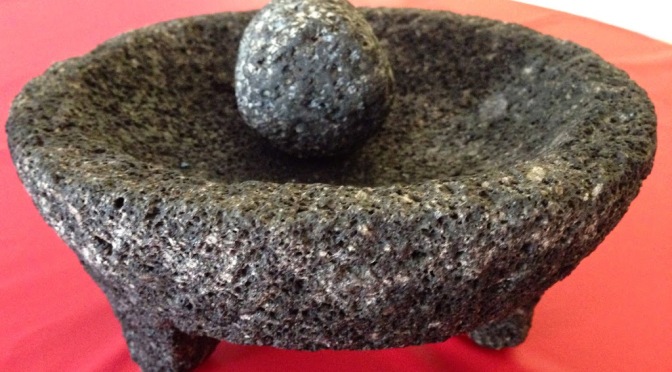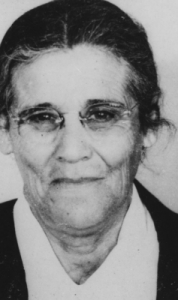My 13th week in Amy Johnson Crow’s “52 Ancestors in 52 Weeks” family history blogging challenge.
The challenge: have one blog post each week devoted to a specific ancestor. It could be a story, a biography, a photograph, an outline of a research problem — anything that focuses on one ancestor.
I’m no longer a few weeks behind in this series. I am now 8 weeks behind in this series (the challenge just wrapped up week 20). I initially blamed my tardiness on being super busy at home, work, and with my volunteer work. However, the extended lapse can be blamed on the recent diagnosis of some critical health issues that had wiped me out for a while (you can read about that on my food blog).
 |
| Nana’s molcajete. Passed down to Dad. Passed down to me. |
This 13th “ancestor”, or more accurately, ancestral focus, is an object — my great grandmother’s molcajete. Molca what??? According to Wikipedia:
A molcajete (mo̞lkaˈxe̞te̞ or mol-cah-hay’-tay; Mexican Spanish, from Nahuatl mulcazitl) is a stone tool, the traditional Mexican version of the mortar and pestle,[1] similar to the South American batan, used for grinding various food products. The molcajete was used by pre-Hispanic Mesoamerican cultures, including the Aztec and Maya, stretching back several thousand years. Traditionally carved out of a single block of vesicular basalt, molcajetes are typically round in shape and supported by three short legs. They are frequently decorated with the carved head of an animal on the outside edge of the bowl, giving the molcajete the appearance of a short, stout, three-legged animal. The pig is the most common animal head used for decoration of this type. The matching hand-held grinding tool, known as a tejolote (Mexican Spanish, from Nahuatl texolotl), is also made of the same basalt material.
My great grandmother, Maria (NIETO) Robledo (1887-1974) “Nana”, used this molcajete daily in her humble kitchen to prepare meals for her husband, her children, her grandchildren, and her great grandchildren. Particularly to grind chilies and other spices for salsa, guacamole, her red chili sauce, and her many delicious Mexican dishes.
When Nana died, this molcajete was passed down to my father, one of three grandchildren she raised. Dad was the grandchild who spent the most time in the kitchen with Nana, learning the treasured family recipes that Nana brought with her from Mexico when she immigrated to the U.S. in 1915 — the same recipes she learned from her mother.
On March 15th, Nana’s molcajete became mine, when Dad surprised me by asking if I would like it. It sits on my fruit stand, where every day I think of Nana while grabbing a banana, apple, or tomato. I haven’t used it yet. Someday.
I asked Dad if Nana brought this molcajete with her from Mexico, but he thinks she purchased it after she arrived here. Nonetheless, I’m thrilled to be the owner of this tool that played such an important role in my great grandmother’s home and family.
[contentblock id=3 img=html.png]


Hello,
My name is Trevor Shaw. I am researching my mother’s molcajete for my high school Spanish class. Will you please consider allowing me to use your story above in my project? Of course I will credit the information to you in my research.
Thank you,
Trevor Shaw
PS my great-great-grandmother and great-grandmother used their molcajete daily too. Ours is sitting on the counter of a daily reminder of days gone by.